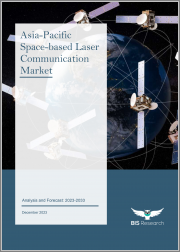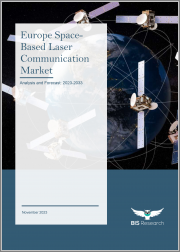
|
시장보고서
상품코드
1395423
아시아태평양의 우주 기반 레이저 통신 시장 - 분석 및 예측(2023-2033년)Asia-Pacific Space-based Laser Communication Market - Analysis and Forecast, 2023-2033 |
||||||
아시아태평양의 우주 기반 레이저 통신 시장 규모는 2022년 약 1억 2,000만 달러에 달할 것으로 예상됩니다.
이 시장은 2033년 28억 8,000만 달러에 달할 것으로 예상되며, 예측 기간인 2023-2033년 동안 26.38%의 연평균 복합 성장률(CAGR)을 나타낼 것으로 예측됩니다. 위성 간 링크(ISL)를 갖춘 2세대 위성이 도입된 이후 우주 기반 레이저 통신 시장은 크게 성장하고 있습니다. 인공지능(AI), 전자제어 안테나(ESA), 부품 소형화, 위성 간 링크(ISL) 등 지상과 우주 공간 모두에서 통신 성능을 향상시키는 기술이 이러한 성장의 주요 원동력이 되고 있습니다.
| 주요 시장 통계 | |
|---|---|
| 예측 기간 | 2023년-2033년 |
| 2023년 평가액 | 2억 7,000만 달러 |
| 2033년 전망 | 28억 8,000만 달러 |
| CAGR | 26.38% |
아시아태평양의 우주 기반 레이저 통신 시장은 최근 몇 년동안 크게 성장하고 발전하고 있습니다. 위성 네트워크의 능력을 향상시키고 디지털 격차를 해소할 수 있는 잠재력을 가진 레이저 기반 위성 통신은 실행 가능한 옵션을 제시하고 있습니다. 에지 컴퓨팅, 가상 사설망, 첨단 5G/6G 서비스, 우주와의 원활한 인터넷 연결 등 다양한 용도로 활용될 수 있습니다. 또한, 레이저 기반 위성 통신이 제공할 수 있는 또 다른 유용한 응용 분야는 공중의 자산과 통신할 수 있는 능력입니다.
또한, 아시아태평양의 위성 별자리들이 시장을 주도할 것으로 예상됩니다. 이러한 위성 별자리들은 세계 또는 거의 세계를 커버하여 위성의 상시 사용을 보장하고, 세계 포지셔닝 시스템, 데이터 중계, 통신, 지구 관측 및 기타 용도를 위한 끊김 없는 연결과 데이터 수집을 용이하게 합니다. 위성 별자리 관측은 APAC 지역의 통신, 우주 탐사, 기후 모니터링, 감시, 보안 및 기타 산업에 새로운 가능성을 제공합니다.
이 보고서는 아시아태평양의 우주 기반 레이저 통신 시장을 조사했으며, 시장 개요와 함께 최종 사용자별/솔루션별/지역별 동향, 시장 진출기업 프로파일 등을 제공합니다.
목차
주요 요약
조사 범위
제1장 시장
- 업계 전망
- 비즈니스 역학
제2장 아시아태평양
- 우주 기반 레이저 통신 시장(지역별)
- 아시아태평양
- 시장
- 용도
- 제품
- 아시아태평양(국가별)
제3장 시장 - 경쟁 벤치마킹과 기업 개요
- 경쟁 벤치마킹
- 기타 주요 시장 진출기업
제4장 조사 방법
LSH 23.12.21“The Asia-Pacific space-based laser communication market Expected to Reach $2.88 Billion by 2033.”
Introduction to Asia-Pacific (APAC) Space-Based Laser Communication Market
In 2022, the Asia-Pacific region generated around $0.12 billion in 2022 and is expected to reach $2.88 billion by 2033, registering a CAGR of 26.38% during the forecast period 2023-2033. Since the introduction of second-generation satellites with intersatellite links (ISL), the market for space-based laser communication has grown significantly. Technologies that improve communication performance both on Earth and in space, like artificial intelligence (AI), electronically steered antennas (ESAs), part miniaturization, and intersatellite linkages (ISLs), are the main drivers of this growth.
| KEY MARKET STATISTICS | |
|---|---|
| Forecast Period | 2023 - 2033 |
| 2023 Evaluation | $0.27 Billion |
| 2033 Forecast | $2.88 Billion |
| CAGR | 26.38% |
Market Introduction
The market for space-based laser communication in the Asia-Pacific region has grown and advanced significantly in recent years. With the potential to improve satellite networks' capabilities and bridge the digital divide, laser-based satellite communication presents a viable option. It can be used for a number of purposes, including edge computing, virtual private networks, advanced 5G/6G services, and seamless internet connectivity to and from space. Furthermore, another useful application that laser-based satellite communication can offer is the capacity to communicate with assets that are in the air.
Furthermore, satellite constellations in the Asia-Pacific area are anticipated to drive the market. These constellations provide worldwide or nearly worldwide coverage, guaranteeing constant satellite availability and facilitating unbroken connectivity and data gathering for uses such as global positioning systems, data relay, telecommunications, and Earth observation. Satellite constellations offer new possibilities for industries such as telecommunications, space exploration, climate monitoring, surveillance, and security in the APAC region.
Market Segmentation:
Segmentation 1: by End User
- Government and Military
- Commercial
Segmentation 2: by Solution
- Space-to-Space
- Space-to-Other Application
- Space-to-Ground Station
Segmentation 3: by Region
- Asia-Pacific - China, India, Japan, and Rest-of-Asia-Pacific
How can this report add value to an organization?
Growth/Marketing Strategy: The APAC space-based laser communication market has seen major development by key players operating in the market, such as contract, collaboration, and joint venture. The favored strategy for the companies has been contracts to strengthen their position in the global space-based laser communication market.
Competitive Strategy: Key players in the APAC space-based laser communication market analyzed and profiled in the study involve major space-based laser communication companies providing components. Moreover, a detailed market share analysis of the players operating in the space-based laser communication market has been done to help the reader understand how players stack against each other, presenting a clear market landscape. Additionally, comprehensive competitive strategies such as partnerships, agreements, and collaborations will aid the reader in understanding the untapped revenue pockets in the market.
Methodology: The research methodology design adopted for this specific study includes a mix of data collected from primary and secondary data sources. Both primary resources (key players, market leaders, and in-house experts) and secondary research (a host of paid and unpaid databases), along with analytical tools, are employed to build the predictive and forecast models.
Table of Contents
Executive Summary
Scope of the Study
1. Market
- 1.1. Industry Outlook
- 1.1.1. Space-Based Laser Communication Market: An Overview
- 1.1.2. Current and Emerging Technological Trends
- 1.1.2.1. Development of Smaller and Lighter Laser Communication Systems
- 1.1.2.2. Multicarrier Modulation (MCM) to Enhance Operational Efficiency in Satellite Connectivity
- 1.1.3. Advancements in Laser Communication Technology and the Potential for Global Coverage
- 1.1.3.1. Revolutionizing Communication: Advantages of Laser Communications Over Traditional Methods (Fiber Connection)
- 1.1.3.2. Laser Communication's Potential for Telecom Cost Reduction in Comparison to Fiber Network
- 1.1.4. Qualitative Analysis of Optical Ground Systems and Scope for Expansion
- 1.1.5. Ongoing and Upcoming Projects
- 1.1.5.1. Space-Based Adaptive Communications Node Program (Space-BACN)
- 1.1.5.2. Deep Space Optical Communications (DSOC)
- 1.1.5.3. Development and Demonstration of Inter-Satellite Optical Communication Network System
- 1.1.5.4. BlackJack Program
- 1.1.5.5. Integrated LCRD Low-Earth Orbit User Modem and Amplifier Terminal (ILLUMA-T)
- 1.1.5.6. Network of Optical Stations for Data Transfer to Earth from Space (NODES)
- 1.1.5.7. Artemis 2 Optical Communications System (O2O)
- 1.1.6. Mega Constellation: A Key Driver for the Expansion of the Space-Based Laser Communication Market
- 1.1.6.1. Increasing Deployment of Mega Constellation
- 1.1.7. Scenario Comparison: Space-based Laser Communication Market
- 1.1.8. Start-Ups and Investment Scenario
- 1.1.9. Supply Chain Analysis
- 1.2. Business Dynamics
- 1.2.1. Business Drivers
- 1.2.1.1. Deployment of Quantum Key Distribution for Secure Data Exchange
- 1.2.1.2. Rising Demand for High-Speed Data Transmission
- 1.2.1.3. Low Data Latency Using GEO Relay or LEO Constellation
- 1.2.2. Business Challenges
- 1.2.2.1. Distortions in Laser Signals During Space-to-Ground Communication
- 1.2.2.2. Use of Higher Optical Power in Comparison to Terrestrial Application
- 1.2.2.3. Need for Accurate Beam Pointing
- 1.2.3. Business Strategies
- 1.2.3.1. New Product Launches, Developments, and Others
- 1.2.4. Corporate Strategies
- 1.2.4.1. Partnerships, Collaborations, Agreements, Contracts and Others
- 1.2.5. Business Opportunities
- 1.2.5.1. Direct Data Downstream from LEO Earth Observation Satellites-to-Ground
- 1.2.5.2. Enhancement and Development of Optical Ground Station Design for Coherent Communication
- 1.2.1. Business Drivers
2. Asia-Pacific
- 2.1. Space-Based Laser Communication Market (by Region)
- 2.2. Asia-Pacific
- 2.2.1. Market
- 2.2.1.1. Key Manufacturers and Suppliers in Asia-Pacific
- 2.2.1.2. Business Drivers
- 2.2.1.3. Business Challenges
- 2.2.2. Application
- 2.2.2.1. Asia-Pacific Space-Based Laser Communication Market (by End User), Value and Volume Data
- 2.2.3. Product
- 2.2.3.1. Asia-Pacific Space-Based Laser Communication Market (by Solution), Value and Volume Data
- 2.2.4. Asia-Pacific (by Country)
- 2.2.4.1. China
- 2.2.4.1.1. Market
- 2.2.4.1.1.1. Key Manufacturers and Suppliers in China
- 2.2.4.1.2. Application
- 2.2.4.1.2.1. China Space-Based Laser Communication Market (by End User), Value and Volume Data
- 2.2.4.1.3. Product
- 2.2.4.1.3.1. China Space-Based Laser Communication Market (by Solution), Value and Volume Data
- 2.2.4.1.1. Market
- 2.2.4.2. India
- 2.2.4.2.1. Market
- 2.2.4.2.1.1. Key Manufacturers and Suppliers in India
- 2.2.4.2.2. Application
- 2.2.4.2.2.1. India Space-Based Laser Communication Market (by End User), Value and Volume Data
- 2.2.4.2.3. Product
- 2.2.4.2.3.1. India Space-Based Laser Communication Market (by Solution), Value and Volume Data
- 2.2.4.2.1. Market
- 2.2.4.3. Japan
- 2.2.4.3.1. Market
- 2.2.4.3.1.1. Key Manufacturers and Suppliers in Japan
- 2.2.4.3.2. Application
- 2.2.4.3.2.1. Japan Space-Based Laser Communication Market (by End User), Value and Volume Data
- 2.2.4.3.3. Product
- 2.2.4.3.3.1. Japan Space-Based Laser Communication Market (by Solution), Value and Volume Data
- 2.2.4.3.1. Market
- 2.2.4.4. Rest-of-Asia-Pacific
- 2.2.4.4.1. Market
- 2.2.4.4.1.1. Key Manufacturers and Suppliers in Rest-of-Asia-Pacific
- 2.2.4.4.2. Application
- 2.2.4.4.2.1. Rest-of-Asia-Pacific Space-Based Laser Communication Market (by End User), Value and Volume Data
- 2.2.4.4.3. Product
- 2.2.4.4.3.1. Rest-of-Asia-Pacific Space-Based Laser Communication Market (by Solution), Value and Volume Data
- 2.2.4.4.1. Market
- 2.2.4.1. China
- 2.2.1. Market
3. Markets - Competitive Benchmarking & Company Profiles
- 3.1. Competitive Benchmarking
- 3.2. Other Key Participants
4. Research Methodology
- 4.1. Factors for Data Prediction and Modeling

















